Ministry of Jal Shakti
YEAR END REVIEW 2022: DEPARTMENT OF DRINKING WATER AND SANITATION, MINISTRY OF JAL SHAKTI
10.8 Crore Rural Households Provided Tap Water Connections Under Jal Jeevan Mission
Over 1 Lakh Villages Declared ODF Plus in 2022 Under SBM-G (Phase II) Which Aims To Convert All Villages From ODF to ODF Plus by 2024-25
Jal Jeevan Mission [JJM]: Key Highlights of 2022
Jal Jeevan Mission Is On Track To Fulfill Government's Resolve To Provide Tap Water Supply To Every Rural Household By 2024
प्रविष्टि तिथि:
27 DEC 2022 7:40PM by PIB Delhi
The Government of India in partnership with States is implementing Jal Jeevan Mission (JJM) to make provision of tap water supply to every rural household by 2024. On 15th August 2019, when Prime Minister, Shri Narendra Modi announced Jal Jeevan Mission from the ramparts of Red Fort, only 3.23 Crore (17%) rural households out of a total of 19.35 Crore rural households had access to tap water supply in their households. India has resolved to make provision for tap water supply in the remaining 16.12 Crore families by 2024. As on 21st December 2022, more than 10.76 Crore (55.62 %) of rural households are being provided with tap water connection in adequate quantity, of prescribed quality on regular basis. Four States namely Goa, Telangana, Gujarat, and Haryana and 3 Union Territories of Puducherry, Daman & Diu and Dadra & Nagar Haveli and Andaman & Nicobar Islands, reported as Har Ghar Jal, i.e. every rural household has provision of tap water supply. Punjab (99.93%), Himachal Pradesh (97.17%) and Bihar (95.76%) are on the verge of becoming ‘Har Ghar Jal’.
- As the country celebrates Azadi ka Amrit Mahotsav, to mark 75 years of India’s Independence, Jal Jeevan Mission (JJM) has achieved a new milestone by providing 10 Crore rural households with safe and clean drinking water through taps on 19th August 2022
- In Goa, Telangana, Gujarat, Haryana, Puducherry, D&D and D&NH, and A&N Islands, every rural household has tap water supply
- Till date, 125 Districts and 1,61,704 villages in the country reported as “Har Ghar Jal”
- Burhanpur District of Madhya Pradesh becomes the first ‘Har Ghar Jal’ certified district in India in July, 2022
- Goa becomes the First ‘Har Ghar Jal’ Certified State & Dadra & Nagar Haveli and Daman & Diu becomes the First ‘Har Ghar Jal’ Certified UT in India in August, 2022
- All 2.63 lakh rural households of Goa & 85,156 households of Dadra & Nagar Haveli and Daman & Diu have access to potable water through tap connection
- Andaman and Nicobar Islands becomes first ‘Swachh Sujal Pradesh’ in India in September, 2022
- Till date, 8.73 Lakh (84.83%) schools and 9.02 lakh (80.79%) Anganwadi Centers across the country have been provided with potable tap water supply for drinking& cooking mid-day meals and hand washing.
- Till date, 5.18 lakh Village Water & Sanitation Committee/Paani Samitis formed, and 5.09 lakh Village Action Plans (VAPs) developed for sustained drinking water supply management
- So far, 16.22 Lakh women have been trained in 1.95 lakh villages on Water Quality Testing through Field Test Kits (FTKs)
- During the FY 2022-23, more than 27.16 Lakh water samples have been tested in laboratories and 57.99 Lakh samples have been tested using Field Test Kits (FTKs)
- Union Minister of Jal Shakti Shri Gajendra Singh Shekhawat presented the first copies of Swachh Survekshan 2022 and JJM Functionality Assessment 2022 to the President of India on the eve of ‘Swachh Bharat Divas’ on 2nd October, 2022
- Vice President, Shri Jagdeep Dhankhar launches Jal Jeevan Survekshan (JJS) Toolkit & Dashboard 2023
- Jal Jeevan Mission strives for the freedom of mothers and sisters from the centuries-old drudgery of fetching water for the household and improving their health, education, and socio-economic condition
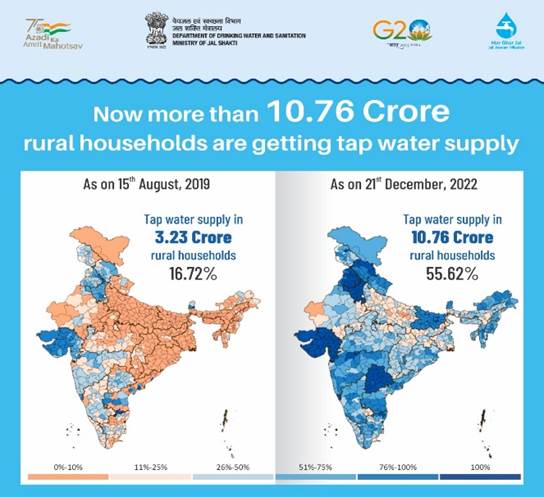
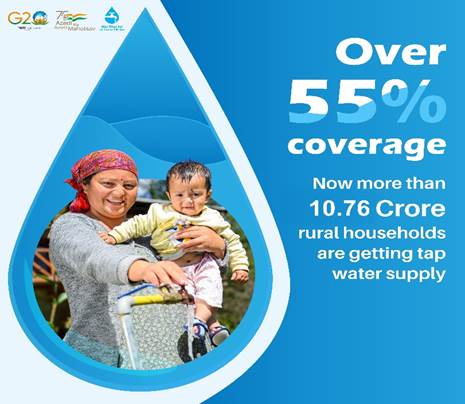
Har Ghar Jal certification:
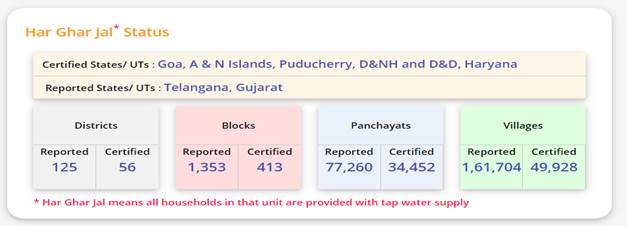
Once a village is declared as Har Ghar Jal, the Gram Panchayat of that village conducts a special Gram Sabha and passes a resolution with the concurrence of all the village members that all the households, schools, Anganwadi, and public institutions in their village have functional tap connection and thus declare themselves as 'Har Ghar Jal Certified. As on date, 56 districts, 413 blocks, 34,452 panchayats, and 49,928 villages are ‘Har Ghar Jal’ certified i.e., all the households have access to tap water connection.
Coverage of potable tap water to JE-AES affected districts
The government of India accords priority to Japanese Encephalitis (JE)-Acute Encephalitis Syndrome[1] (AES) affected Districts to ensure potable tap water supply in all the households under Jal Jeevan Mission. In 61 districts affected with JE/AES across 5 states, tap water connection increased from 8 lakh (2.69%) to 147.14 lakh (49.29%) households, resulting in improvement in the health profile of the rural population of these areas.
Coverage of potable tap water in Aspirational districts
There are 112 Aspirational districts of which 8 districts have provided 100% tap water connection to its rural households. Today, out of a total of 2.77 Crore households in Aspirational districts, 1.49 Crore households (53.99%) are getting water through taps which at the time of the launch was only 21.66 lakh (7.83%).
Provision of drinking water supply in public institutions (Schools and Anganwadi Centers):
Safe water for children is critical for their well-being and holistic development. Jal Jeevan Mission is proving to be a game-changer for children's health, as potable drinking piped water supply is being provided on a priority basis in schools and anganwadi centers (day care) which will greatly reduce the occurrence of water related ailments among children. Infants and young children will be less prone to water-borne diseases and an end to open defecation will result in reduced incidences of child deaths due to diarrhoeal disease.
With a focus on better health and well-being of children, a special campaign was started by the Union Minister of Jal Shakti, Shri Gajendra Singh Shekhawat, on ‘Gandhi Jayanti' in 2020 to make provision for piped water supply in schools and Anganwadi centres for drinking, cooking, hand washing, and usage in toilets.
The continuous relentless effort by the government has resulted in ensuring tap water supply in more than 8.72 lakh (84.83%) schools and 9.02 lakh (80.79%) Anganwadi Centers. 4 States and 5 UTs have ensured 100% tap water connectivity in schools and Anganwadi centers. The remaining States/ UTs are working hard to provide tap connections in schools and Anganwadi centers so that our children get access to safe water which plays a major role in the reduction of infant and maternal mortality.
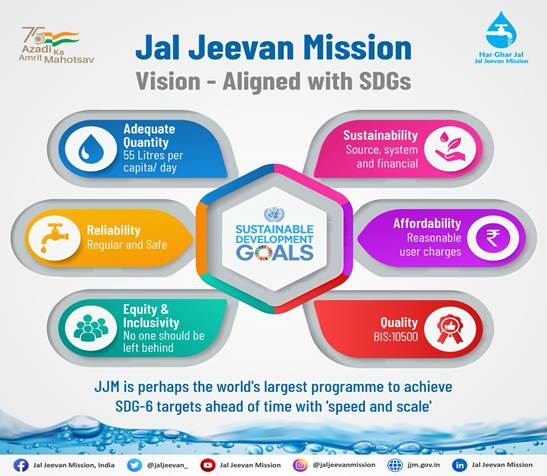
Status of Water Quality Monitoring and Surveillance:
Ensuring water quality is one of the main objectives of the Jal Jeevan Mission. To ensure that the supplied water is of adequate quality, the program promotes regular testing of water samples at source and delivery points. There are a total of 2,074 water testing laboratories in the country. Of these, 1,005 are NABL accredited. Water quality testing labs of States/ UTs are now open for the public for testing water samples at nominal rates. In 2022-23, as of date, more than 27 lakh water samples have been tested in laboratories.

To promote women participation, at least five women in every village are being trained to use Field Test Kits (FTKs) for testing water quality at the village level. So far, more than 16.21 Lakh women have been trained in 1.95 lakh villages. During the FY 2022-23, more than 57.99 Lakh water samples have been tested using Field Test Kits (FTKs).
Village Water & Sanitation Committee (VWSC) formation and Village Action Plans (VAPs):
Over 5.17 lakh Village Water and Sanitation Committees (VWSCs)/ Paani Samitis have been constituted under the programme. The Paani Samiti is responsible for management and regular operation and maintenance of in-village water supply system including local water sources. So far, 5.08 lakh Village Action Plans have been developed which detail out the type of water supply scheme required, cost estimates, implementation schedule, O&M arrangement and contribution from each household towards partial capital cost.
Funds Allocation for Jal Jeevan Mission:
The estimated outlay of Jal Jeevan Mission under 'Har Ghar Jal' program is Rs. 3.6 Lakh Crore for the period of five years from 2019-2024. The 15th Finance Commission has identified water supply and sanitation as a national priority and allocated funds of Rs. 2.36 lakh Crore to Rural Local Bodies/Panchayat Raj Institutions (RLBs/PRIs) for the period 2021-22 to 2025-26[2]. Accordingly, 60% of the fund, i.e., Rs. 1.42 lakh Crore provided as Tied Grants meant to be utilized exclusively for the drinking water, rainwater harvesting and sanitation & maintenance of open-defecation free (ODF) village. This huge investment in rural areas across the country is accelerating economic activities and boosting the rural economy, as well as creating employment opportunities in villages. This is a progressive step to ensure that villages have potable water supply with improved sanitation for transforming the villages into 'WASH enlightened ' villages.
In 2022-23, so far, the Government of India has released Rs.22,975.34 Crore to 21 eligible States for the implementation of Jal Jeevan Mission in the financial year 2022-23[3].
The Central funds are released by the Government of India based on the utilization of available Central funds and matching State share. For online monitoring, Integrated Management Information System (IMIS) and JJM–Dashboard have been put in place. Provision has also been made for transparent online financial management through Public Financial Management System (PFMS).
The details of Central funds allocated, funds drawn, and funds utilization reported in the year 2019-20, 2020-21, 2021-22, and 2022-23[4] under JJM is as below:
(Amount in Rs. Crore)
|
Year
|
Central
|
Utilization under State share
|
|
Opening Balance
|
Funds allocated
|
Funds drawn by State/UT
|
Reported utilization
|
|
2019-20
|
2,436.37
|
11,139.21
|
9,951.81
|
5,998.99
|
4,066.88
|
|
2020-21
|
6,431.85
|
23,033.02
|
10,917.90
|
12,542.03
|
7,803.36
|
|
2021-22
|
4,812.91
|
92,308.77
|
40,009.80
|
25,516.01
|
18,532.80
|
|
2022-23
|
19,319.03
|
1,00,789.77
|
22,975.34
|
26,543.59
|
18,418.52
|
Skilling:
JJM aims to build the capacity of people to support and working as masons, mechanics, plumbers, pump operators, technicians, utility managers, and water testing laboratory in-charge. With major infrastructure development taking place across the country a lot of employment opportunities are getting generated at all levels for skilled, semi-skilled, and unskilled labour force. Local people were trained as masons, plumbers, pump operators, motor mechanics, electricians, and fitters.
Capacity building through Key Resource Centers:
For building capacity and reorienting the different stakeholders, 100 reputed Governmental and non- Governmental academic institutions/ agencies/ firms/ organizations/ think tanks/ training institutions, etc. are engaged as Key Resource Centres (KRCs). 104training programmes have been organized for various stakeholders and around 4,000 persons trained on various aspects of drinking water under JJM during FY 2022-238.
Implementation Support Agencies (ISAs):
The States/ UTs are extending support to the Panchayats by engaging Implementation Support Agencies (ISAs) to facilitate constitution of VWSC, under participatory rural appraisal for community mobilization, support in preparing Village Action Plan and carry out activities post infrastructure construction. About 14 thousand ISAs have been engaged, which are actively working in the field.
National WASH Expert:
National Centre for Drinking Water, Sanitation, and Quality has been entrusted with the task of empanelment and deployment of National WASH Experts for ground truthing and technical assistance to States in the implementation of the Jal Jeevan Mission (JJM). So far 46 NWEs are empaneled. During the year, 62 teams have visited around 1,035 villages for ground truthing of the implementation work done under JJM. Based on the status of implementation of JJM, the NWEs are providing star ratings to villages and feedback to States in terms of progress of implementation of JJM in three categories namely Satisfactory, Satisfactory but improvement needed, and unsatisfactory, immediate action needed. The NWEs provide their feedback to concerned State authorities after the completion of the visit.
Rural WASH Partners Forum (RWPF):
The Department of drinking water & Sanitation has set up a forum, where development partners along with sector partners can come forward, support, and work collaboratively with the Government of India and State/ UTs for the effective implementation of the Jal Jeevan Mission and Swachh Bharat Mission (Grameen). The 2nd event of Rural WASH Partners’ forum was held on 2nd Nov and was chaired by the Union Minister of Jal Shakti, Shri Gajendra Singh Shekhawat.
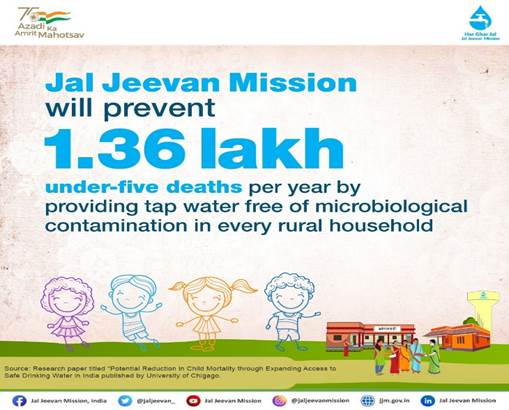
Sector Partners:
To make water 'everyone's business, the mission strives to build partnerships and work together with various institutions/ individuals to achieve long-term drinking water security for all. 212 Voluntary Organizations (VOs), Non-Governmental Organizations (NGOs), Social service & charity organizations, and professionals/ individuals already working in the field of water are recognized as 'Sector Partners' in this ambitious program to address the challenges holistically.
Professor Chairs and Centre of Excellence:
To carry out high quality research and address sectoral challenges in rural drinking water and sanitation sector,5 (five) Jal Jeevan Mission Professor Chairs have been established in IIM Bengaluru, IIT Jodhpur, IIT Guwahati, TISS Mumbai & IIT Kanpur on various focus areas of JJM. Also 2 (two) Centers of Excellence have been established in IIT Madras and IIT Gandhi Nagar to do research, studies and provide support on various sectoral challenges on drinking water under JJM.
Reduction of water borne diseases
As per the report from National Centre for Disease Control (NCDC), with the availability of safe and potable drinking water at the doorstep of every rural household, the water-borne disease has been drastically reduced. The details of reduction in water borne diseases in previous three years is tabulated herewith.
|
Year
|
Water-borne diseases
|
|
2019
|
177 Lakhs
|
|
2020
|
89 Lakhs
|
|
2021
|
59 Lakhs
|
|
Source: National Centre for Disease Control (NCDC)
|
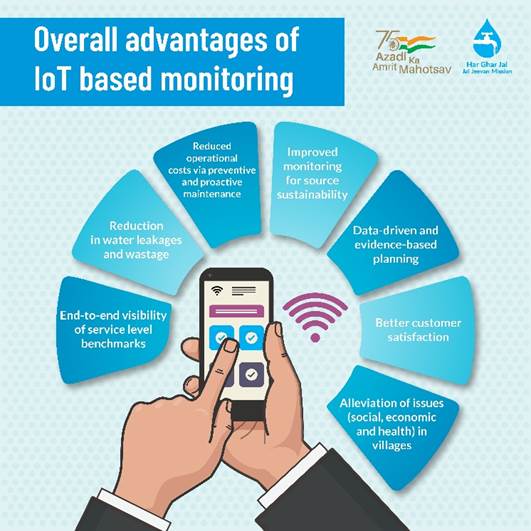
Use of technologies for drinking water supply and water quality
Jal Jeevan Mission focuses on various technologies for the community-led implementation of (i) source sustainability measures such as aquifer recharge, rainwater harvesting, increased storage capacity of water bodies, reservoirs, de-silting, etc. to improve the lifespan of water supply systems (ii) water budgeting and audits (iii) operation and maintenance (iv) grey water management (v) water quality monitoring and surveillance (vi) pre-positioned emergency water supply kits to provide transitional services in camps (vii) solar based water supply schemes using solar energy are steps intended to reduce the carbon footprints (viii) the technologies like IoT for SCADA, remote sensing &GIS, design software has been used in building climate resilience through water accounting, water quality control, water use efficiency, water resource planning, and impact assessment. IoT Pilots are being implemented in 118 villages in 14 States/UTs. 25 innovative projects related to water are recommended by Technical Committee for water treatment, water quality & monitoring, IoT-based Battery Vehicles, and Software for the hydraulic design of water treatment plants in rural India.
Reducing the Non-Revenue Water:
The community-led water audits and water security planning is crucial to reduce the real and apparent losses in the water supply distribution system and non-revenue water. IoT-based technology, water metering, installation of flow control valves in water connection, water budgeting, community surveillance, water conservation measures and convergence with various water-related programs, IEC activities for long-term water security, etc. are being taken up to strengthen water supply management for all.
Grievance Redressal Mechanism:
Grievance Redressal Cell has been constituted in the Department to address the grievances related to the water supply. People are lodging their compliant through the Centralized Public grievances Redress and Monitoring System (CPGRAMS). Constant feedback and suggestions from the recipients and stakeholders regarding the delivery of services are being taken up to improve the service delivery mechanism and make the Department responsive to the needs of the citizens.
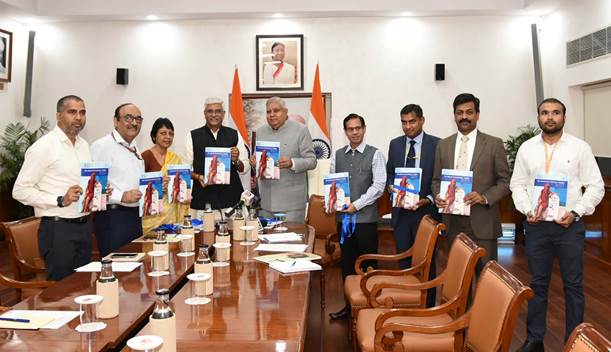
Launch of Jal Jeevan Survekshan (JJS) Toolkit – 2023 and JJS-2023 Dashboard
The Vice President of India, Shri Jagdeep Dhankhar launched ‘Jal Jeevan Survekshan’ toolkit and dashboard on 21st October, 2022. The purpose of Jal Jeevan Survekshan 2023 is to incentivize States/ Districts functionaries to strive for better performances and improved water service delivery in rural areas.
‘Swachh Jal Se Suraksha’: The campaign on water quality will help create awareness on the importance of clean and safe drinking water and also help to monitor the quality of water supplied in rural households. The campaign was launched on2nd October, 2022 and it will continue up to 26th Jan, 2023.
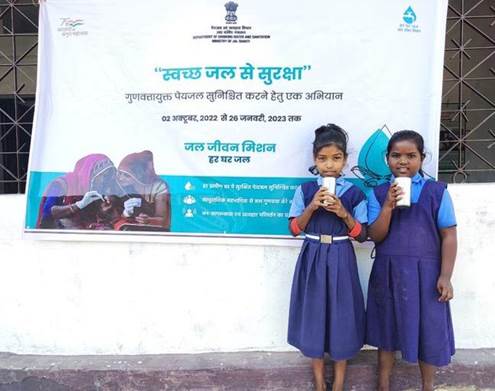
The government in recent years has been working with 'speed and on a scale' to improve quality of life and fulfil peoples' aspirations of basic needs. The expectations of people, especially of those living in villages have increased because of various Government initiatives fulfilling basic needs like housing for all, electricity to every household, toilet to every family, clean cooking gas, financial inclusion, social security, affordable healthcare for all, roads, broadband connectivity, etc. Now, the aspiration of the people is to have potable tap water supply in their homes and public institutions so as to bridge the rural-urban divide. To meet this aspiration of rural India and to enhance their ease of living, Prime Minister Shri Narendra Modi announced Jal Jeevan Mission (JJM).
Announced on 15th August 2019 from the ramparts of Red Fort, JJM is being implemented in partnership with States to make provision of tap water supply in adequate quantity of prescribed quality with adequate pressure on regular and long-term basis to every rural home by 2024. JJM is ensuring 'no one is left out' and that the poorest and marginalized, as well as the previously unreached are all provided assured tap water supply.
What makes JJM unique is that prior to its launch, the basic unit of water supply in rural India was a village/ habitation. Being a transformational programme, 'Jal Jeevan Mission' has now made the household as the basic unit of water supply. It is specifically of historical significance for the women in the country, as JJM will unshackle them from the age-old drudgery of fetching water for the household from afar, day in and day out under even the most severe weather conditions. Thus, JJM will restore their self-respect and will thus save them enough time and energy which they can devote to their self-development.
(For Further Details Visit JJM Dashboard: https://ejalshakti.gov.in/jjmreport/JJMIndia.aspx)
Swachh Bharat Mission (Grameen): Key Highlights of 2022
SBM-G (Phase II) Reinforces ODF Behavior & Focuses On Safe Management Of Solid & Liquid Waste In Villages
Over 1 Lakh Villages Declared ODF Plus in 2022
SBM-G (Phase II) Aims To Convert All Villages From ODF to ODF Plus by 2024-25
Swachh Bharat Mission (Grameen) [SBM(G)], a Centrally Sponsored Scheme, was launched by Prime Minister, Shri Narendra Modi on 2nd October, 2014, with the main aim to make the country Open Defecation Free (ODF) by 2nd October, 2019, the 150th birth anniversary of Mahatma Gandhi, by providing access to toilets to all the rural households in the country. All the villages in the country had declared themselves ODF by 2nd October, 2019. Having achieved the outcome of the ODF, Phase-II of SBM (G) has been launched with effect from 1st April, 2020 with the focus to sustain the ODF status and to cover all villages with solid and liquid waste management (SLWM) i.e. to convert all villages from ODF to ODF Plus by 2024-25. Under the programme it is also to be ensured that no one is left behind. The total programme outlay of SBM(G) Phase-II is over Rs.1.40 lakh crore.
In terms of Physical Achievements so far, more than 11.09 crore IHHLs and 2.18 lakh CSCs have so far been constructed under the programme across the country since 2nd October, 2014, as reported by the States/UTs on the IMIS. In 2022, 23,34,560 IHHLs and 19,169 CSCs have been constructed between 1st January, 2022 to 20thDecember, 2022. 1,24,677 villages have been declared Open Defecation Free (ODF) Plus from 1st January, 2022 to 20thDecember, 2022. For implementation of SBM(G) Rs. 3028 crore have been utilized from 1st January, 2022 to 20th December, 2022.
- 1,24,677 villages declared Open Defecation Free (ODF) Plus between 1st January, 2022 to 20th December, 2022
- 1,25,810 villages have been covered with Solid Waste Management and 1,12,427 villages have been covered with Liquid Waste Management till 20th December, 2022
- 23,34,560 Individual Household Latrines (IHHLs) and 19,169 Community Sanitary Complexes (CSCs) have been constructed since 1st January, 2022 to 20.12.2022
- To prioritize Liquid Waste Management Sujlam campaign was launched. Under Sujlam 1.0 and Sujlam 2.0 campaigns, more than 23 lakh soak pits constructed.
- Under GOBARdhan initiative of SBM(G), 96 community/cluster level Biogas Plants have been established since January 2022.
- For capacity strengthening of SBM-G field functionaries, 2191 Master Trainers have been trained since January, 2022.
- Organised Swachhata Hi Seva (SHS) campaign from 15th September, 2022 to 2nd October, 2022 - 9.81 crore people participated in Shramdaan activities and 14.80 lakh legacy waste sites cleaned.
- To promote safe disposal of faecal sludge through a simple on-site methodology of retrofitting single pit toilet to twin pit toilet, launched ‘Retrofit to Twin Pit Abhiyan’ on 2nd October 2022.
- To create healthy competition amongst States, Districts and Panchayats and to ascertain progress of SBM-G Phase II, launched Swachh Survekshan Grameen (SSG) 2023 on 2nd November 2022.
|
|
ODF Plus declared villages
|
|
Aspiring
|
Rising
|
Model
|
Total
|
|
85,832
|
19,718
|
42,115
|
1,47,665
|
Funds utilized for implementation of SBM(G)
Rs. in crore
|
Year
|
Utilized
|
|
2014-15 to 2021-22
|
78,361.92
|
|
2022-23
|
1716.22
|
- The Liquid Waste Management (LWM) has been prioritized through the campaigns such as Sujlam. Under Sujlam 1.0 and Sujlam 2.0 campaigns, more than 23 lakh soak pits have been constructed by the States/UTs.
- Regional Conferences of State Ministers in charge of sanitation and water supply departments were held under the chairmanship of Union Minister for Jal Shakti.
- For capacity strengthening, various orientations/trainings/workshops were conducted for for various stakeholders at State/District/Block/GP levels including DMs/DCs. 2191 Master Trainers have been trained since January, 2022.
- A Lighthouse Initiative to develop 75 model ODF Plus blocks was launched on July 29, 2022 at New Delhi by DDWS in collaboration with India Sanitation Coalition (ISC).
- The Rural WASH Partners’ Forum (RWPF) meeting was organised on August 22, 2022 at India Habitat Centre, New Delhi. RWPF reiterated its commitment to support States in the implementation of SBM-G and JJM, through innovation, knowledge products, financing and capacity building, leading to impact driven outcomes.
- GOBARdhan: GOBARdhan is an important component of Phase II of Swachh Bharat Mission-Grameen. Its objective is to ensure cleanliness in villages and generate wealth and energy by converting bio-waste including animal waste, agri-residue into bio-slurry and biogas and to improve the lives of villagers. DDWS is also coordinating the implementation of GOBARdhan: Waste to Wealth initiative involving various Departments/ Ministries to provide an enabling environment for Biogas/Compressed Biogas (CBG) sector. Since January 2022, total 96 community/cluster level Biogas Plants have been completed under SBM(G).
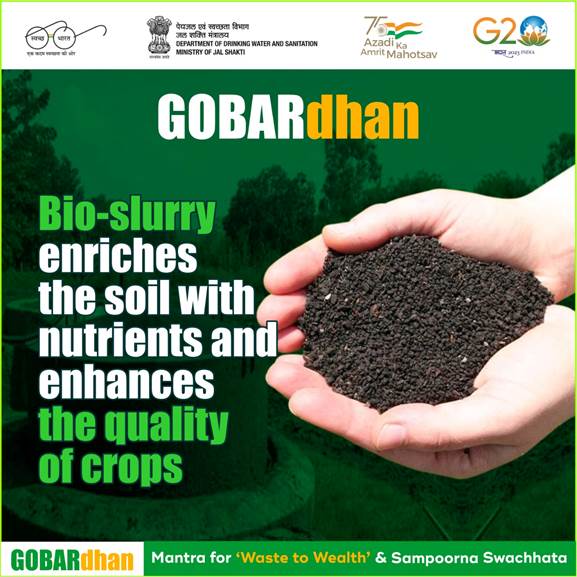
- The monthly newsletter of SBM-G viz "Swachhata Samachar" was launched in August, 2022.
- Swachchata Hi Seva (SHS) campaign was organized from 15th September, 2022 to 2nd October, 2022 throughout the country. Under the campaign, 9.81 crore people participated in Shramdaan activities and 14.80 lakh legacy waste sites were cleaned. 1.68 lakh Sarpanches attended Sarpanch Samvaad organised by the States on ODF Plus components and 1.59 lakh Gram Panchayats passed resolution for banning use of of Single Use Plastics.
- “Swachh Bharat Diwas” was organized on 2nd October, 2022 at Vigyan Bhawan, New Delhi. The President of India, Smt. Droupadi Murmu had graced the event. On the occasion, Shri Giriraj Singh, Minister of Rural Development and Panchayati Raj; Shri Gajendra Singh Shekhawat, Minister of Jal Shakti; Shri Bishweswar Tudu, Minister of State for Jal Shakti and Tribal Affairs; Shri Prahlad Singh Patel, Minister of State for Jal Shakti and Food Processing Industries, were also present. The President released the reports of Swachh Survekshan Grameen (SSG), 2022 and Jal Jeevan Mission JJM) - Functionality Assessment. She also honored the best performer States/UTs and Districts under SSG 2022 and JJM-Functional Assessment and presented awards to them. The Union Minister of Jal Shakti also gave various awards to the performers/winners under different campaigns and competitions. More than 1,500 people including State Ministers, senior officers from Central and State/UT governments, and development partner organisations, Panchayati Raj Institutions (PRI) members and other stakeholders, media persons participated in the event.
- Retrofit to Twin Pit Abhiyan launched by Union Minister of Jal Shakti, Shri Gajendra Singh Shekhawat, on 2nd October 2022. The campaign will promote the safe disposal of faecal sludge through a simple on-site methodology of retrofitting single pit toilet to twin pit toilet. During the first phase of the Campaign from 2nd October to 19th November (the planning phase), States have completed the baseline assessment of 97% villages. The single pit toilets and septic tanks so identified, are to be retrofitted in the implementation phase up to 26th January 2023.

- Launch of Swachh Survekshan Grameen 2023 (SSG 2023): DDWS has launched Swachh Survekshan Grameen (SSG) 2023 on 2nd November 2022 with an objective to create healthy competition amongst States, Districts and Gram Panchayats and to ascertain progress of SBM-G Phase II. Under SSG 2023 assessment will be undertaken at Gram Panchayat and District level. To make SSG 2023 more participatory, Gram Panchayats will undertake village self-assessment on ODF Plus parameters. After completion of village self-assessment, peer verification will be undertaken at Block level by Gram panchayats. Villages shortlisted at Block level will be further assessed at District, State, and National level to identify the best Gram Panchayats across all three levels. Till 20th December, 2022, over 1,80,610Gram Panchayats have started self-assessment process and over 3.26 lakh villages have completed the baseline self-assessment. Performance of districts will be assessed on the basis of progress on ODF Plus indicators and direct observation of villages by engaging third-party agency. Best performing districts are being recognized for monthly and quarterly progress. Best performing States, Districts and Panchayats will be felicitated at national level on 2nd October 2023.
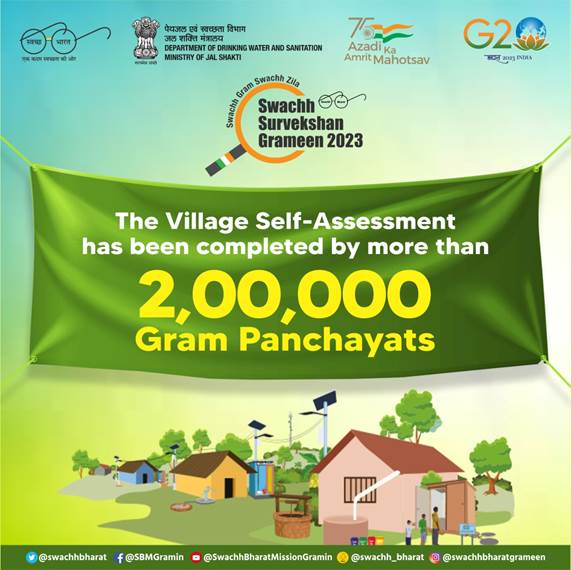
Under SBM(G), incentive of Rs.12000/- (including the State share) is provided for construction of individual household latrine (IHHL) to the eligible households [all the BPL households and identified Above Poverty Line (APL) households (SC/ST, Small and Marginal Farmers, Landless Labourers with Homestead, Physically Handicapped, and Women headed households)]. States have the flexibility to provide higher incentive amount by providing additional State share. Under the programme, financial assistance is also provided to the Gram Panchayats for construction of Community Sanitary Complexes (CSCs) and creation of assets for Solid and Liquid Waste Management (SLWM) in villages.
The fund sharing ratio between the Centre and the States is as under:
- 90:10 for 8 North Eastern States and 3 Himalayan States/UTs of Uttarakhand, Himachal Pradesh and Jammu & Kashmir
- 60:40 for other States
- For other UTs, 100% share is borne by the Centre
Major components of the SBM(G) Phase-II are:
(i) Construction of Individual household latrines (IHHLs) for any left out or newly emerged households
(ii) Construction of Community Sanitary Complex (CSC) in villages on need basis
(iii) Solid and Liquid Waste Management (SLWM) – organic waste management, plastic waste management, greywater management and faecal sludge management
- Information, Education and Communication (IEC) and Capacity Building
The ODF Plus progress is being captured in three categories as under:
- Aspiring-उदीयमान: The village which is sustaining its ODF status, and has arrangements for Solid Waste Management or Liquid Waste Management.
- Rising-उज्जवल: The village which is sustaining its ODF status, and has arrangements for both Solid Waste Management and Liquid Waste Management.
- Model-उत्कृष्ट: The village which is sustaining its ODF status; has arrangements for both Solid Waste Management and Liquid Waste Management; observes visual cleanliness i.e. minimal litter, minimal stagnant wastewater and no plastic waste dump in public places. Displays ODF Plus IEC messages.
Sanitation is a State subject & the programme is being implemented through the State Governments. Govt. of India provides technical and financial support to the States to supplement their efforts to improve overall cleanliness in villages, by way of issuing programme guidelines, advisories and grants-in-aid. The programme is designed as a novel model of convergence between different verticals of financing and various schemes of Government of India and State Governments. Apart from the funds being made available through the budgetary provisions for SBM(G) by the Centre and State Governments, funds are to be dovetailed from the 15th Finance Commission grants to Rural Local Bodies (RLBs), MGNREGS and revenue generation models, etc., particularly for solid and liquid waste management.
*****
AS
[1]https://www.niti.gov.in/aspirational-districts-programme
[2] Manual for the utilization of 15th Finance Commission tied grants to Rural Local Bodies/PRIs for Water & Sanitation (2021-22 to 2025-26)
[3]https://ejalshakti.gov.in/JJM/JJMReports/Financial/JJMRep_StatewiseAllocationReleaseExpenditure.aspx
[4]https://ejalshakti.gov.in/JJM/JJMReports/Financial/JJMRep_StatewiseAllocationReleaseExpenditure.aspx
(रिलीज़ आईडी: 1886953)
आगंतुक पटल : 21554